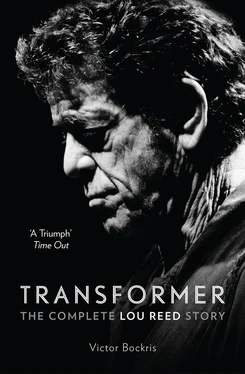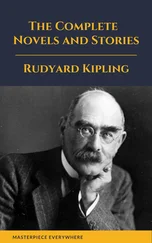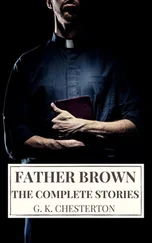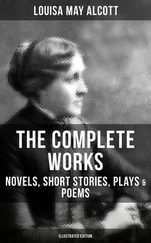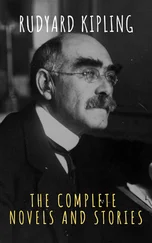Another charge Lou would lob at his unprotected parents was that they were filthy rich. This was, however, purely an invention Lou used to dramatize his situation. During Lou’s childhood his father made a modest salary by American standards. The kitchen-table family possessed a single automobile and lived in a simply though tastefully furnished house with no vestiges of luxury or loosely spent funds. Indeed, by the end of the 1950s, what with the shock treatments, Lou’s college tuition, and their daughter Elizabeth’s coming into her teens, the Reeds were stretched about as far as they could reach.
***
The year of his electroshock treatments, 1959, through the summer of 1960 was a lost time for Lou. From then on, the central theme of his life became a struggle to express himself and get what he wanted. The first step was to remove himself from the control of his family, which he now saw as an agent of punishment and confinement. “I came from this small town out on Long Island,” he stated. “Nowhere. I mean nowhere. The most boring place on earth. The only good thing about it was you knew you were going to get out of there.” In August he registered and published a song called “You’ll Never, Never Love Me.” A gut resentment of his parents was blatantly expressed in another song, “Kill Your Sons.” The music, he later said, gave him back his heartbeat so he could dream again. “The music is all,” he wrote in a wonderful piece of prose called “From the Bandstand.” “People should die for it. People are dying for everything else, so why not for the music. It saves more lives.”
Chapter Two
SYRACUSE UNIVERSITY: 1960–62
Lou liked to play with people, tease them and push them to an edge. But if you crossed a certain line with Lou, he’d cut you right out of his life.
Allen Hyman
In order to continue their friendship, Lou and Allen Hyman had conspired to attend the same university. “In my senior year in high school Lou and I and his father drove up to Syracuse for an interview,” recalled Allen. “We didn’t speak to his father much, he was quiet. Quiet in the sense of being formal—Mr. Reed. We stayed at the Hotel Syracuse, which was then a real old hotel. There were also a bunch of other kids who were up for that with their parents. Would-be applicants to Syracuse. Lou’s father took one room and Lou and I took another. We met a bunch of kids in the hall that were going to Syracuse and we had this all-night party with these girls we met. We thought this was going to be a gas, this is terrific. The following day we both knew people who were going to Syracuse at the time who were in fraternities, and the campus was so nice, I think it was the summer, it was warm at the time, it looked so nice.”
The two boys made an agreement that if they were both accepted, they would matriculate at Syracuse. “We both got in,” said Hyman. “And the minute I got my acceptance I let them know I was going to go and I called Lou very excited and said, “I got my acceptance to Syracuse, did you?” And he said, ‘Yes.’ So I said, ‘Are you going?’ and he said, ‘No.’ And I said, ‘What do you mean, no? I thought we were going, we had an agreement.’ He said, ‘I got accepted to NYU and that’s where I’m going.’ I said, ‘Why would you want to do that, we had such a good time up there, we liked the place, I told them I was going, I thought you were going.’ He said, ‘No, I got accepted at NYU uptown and I’m going.’”
Lewis Reed, 17, 1959. ‘I don’t have a personality.’
In the fall of 1959, Lou headed off to college. Located in New York City, New York University seemed like a smart choice for a man who loved nothing more than listening to jazz at the Five Spot, the Vanguard, and other Greenwich Village clubs. But the Village was not the NYU campus Lou chose. Almost incomprehensibly, he signed up for the school’s branch located way uptown in the Bronx. NYU uptown provided Reed with neither the opportunities nor the support that he needed. Instead, Lou was left floundering in a strange and hostile environment. One of his few pleasures came from visiting the mecca of modern jazz, the Five Spot, regularly, but he didn’t always have the money to get in and often stood outside listening to Thelonious Monk, John Coltrane, and Ornette Coleman as the music drifted out to the street.
However, Lou’s main concern was not college. The Bronx campus was convenient to the Payne Whitney psychiatric clinic on the Upper East Side of Manhattan, where he was undergoing an intensive course of postshock treatments. According to Hyman, who talked to him on the phone at least once a week through the semester, Lou was having a very, very bad time. “He was in therapy three or four times a week,” Hyman recalled. “He hated NYU. He really hated it. He was going through a very difficult time and he was taking medication. He was having a lot of difficulty dealing with college and day-to-day business. He was a mess. He was going through a lot of very, very bad emotional stuff at the time and he probably had something very close to a minor breakdown.”
After two semesters, in the spring of 1960, having completed the Payne Whitney sessions although still on tranquilizers, Lou couldn’t take the NYU scene anymore.
One of the few people who encouraged Lou during his yearlong depression was his stalwart childhood friend, Allen Hyman, who now urged him to get away from his parents. Allen encouraged Lou to join him at Syracuse—a large, prestigious, private university, hundreds of miles from Freeport. In the fall of 1960, shaking off the shadows of Creedmore and the medication of Payne Whitney, Reed took Hyman’s advice and enrolled at Syracuse.
***
The coeducational university, attended by some nineteen thousand sciences and humanities students, had been established in 1870. It was located on a 640-acre campus atop a hill, in the middle of the city. Its $800 per term tuition was relatively high for a private university. Most of the students lived in sororities and fraternities and were enjoying one last four-year party before putting aside childish notions for the economic responsibilities of adulthood. There was, among the student population, a large and wealthy Jewish contingent, generally straight-arrow fraternity men and sorority women bound for careers in medicine and law. There was a small margin of artists, writers, and musicians with whom Lou would throw in his lot, enjoying, for the first time in his life, a niche in which he could find a degree of comfort. Among many other talented and successful people, the artist Jim Dine, the fashion designer Betsey Johnson, and the film producer Peter Guber all graduated in Reed’s class of 1964.
The Syracuse campus looked like the perfect set for a horror movie about college life in the early 1960s. Its buildings resembled Gothic mansions from a screenwriter’s imagination. Indeed, the scriptwriter of The Addams Family TV show of the 1960s, who attended the university at the same time as Lou, used the classically Gothic Hall of Languages as the basis for the Addams Family mansion. The surrounding four-block-square area of wooden Victorian houses, Depression-era restaurants, stores, and bars completed the college landscape. A pervasive ocher-gray paint lent a somber air to the seedy wooden houses tucked away in side streets covered, most of the time, with snow, wet leaves, or rain. The atmosphere was likely to elicit either poetic contemplation or depressive madness. It provided a perfect backdrop for the beatnik lifestyle.
The surrounding city of Syracuse presented no less smashed a landscape. The manufacturing town got dumped with snow seven months of the year, and heavy bouts of rain the rest of the time. Only during the summer, when most of the students had scattered to their homes on Long Island or New Jersey, did the city receive warmth and sunshine. A thriving industrial metropolis popularly known as the Salt City, also specializing in metals and electrical machinery, it was two hundred miles northwest of Freeport, forty miles south of Lake Ontario on the Canadian border, and five miles southwest of Oneida Lake. Syracuse was aggressively conservative and religious, but at the time of Reed’s arrival it was fast turning into the academic hub of the Empire State. The city proudly supported its prestigious university, whose popular football team, the Orangemen, was undefeated during Lou’s four years, and its residents turned out in great numbers for athletic events. Despite high academic standards, Syracuse was still primarily seen as a football school. “Where the vale of Onondaga / Meets the eastern sky / Proudly stands our Alma Mater / On her hilltop high” ran the opening verse of the school song, a ditty Lewis, as many of his friends called him, would not forget.
Читать дальше
